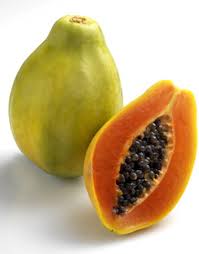
Hawaii is known for many things including their unique cuisine. Because it is a series of Island and the mainlands are so far away the people of Hawaii subside mostly on things that can be grown or produced locally. This happens for two reasons. 1.) these are the items that are most fresh and 2.) these are the items that are least expensive since they do not have to travel as far to get to the consumer.
Today we are going to talk a little about two foods that many people are well aware of and probably eat on the mainland and one food that many locals love but visitors avoid with a ten foot pole.
Pineapple:

Everybody's favorite tropical fruit. Raw pineapple is an excellent source of manganese and vitamin C.
It contains a proteolytic enzyme, bromelain, which breaks down protein. Because of this pineapple juice can thus be used as a marinade and tenderizer for meat.
One thing that I remember from foods classes in college is that the enzymes in raw pineapples can interfere with the preparation of some foods, such as jelly or other gelatin-based desserts. Meaning, don't put raw pineapple into jello. Canned is fine.
And lastly, what would my tropical drink be without pineapple?

Papaya:

Papaya contains a proteolytic enzyme called papain which helps in digestion. It assists our body's own enzymes in assimilating the maximum nutritional value from the food we eat. It is a rich source of anti-oxidant nutrients such as beta-carotene, vitamin A and C and flavonoids, B vitamins, folate and pantothenic acid and also contains small amounts of of the minerals calcium, chlorine, iron, phosphorus, potassium, silicon and sodium.
Fun Fact #1: In some cultures papaya is also applied topically for the treatment of cuts, rashes, stings and burns.
Fun Fact #2: Did you know that Harrison Ford was treated for a ruptured disc incurred during the filming of Indiana Jones and the Temple of Doom by papain injections?
Poi:

Poi is a Hawaiian word for the primary Polynesian staple food made from the corm of the taro plant (known in Hawaiian as kalo). Poi is produced by mashing the cooked corm (baked or steamed) until it is a highly viscous fluid. Water is added during mashing and again just before eating, to achieve a desired consistency, which can range from liquid to dough-like (poi can be known as two-finger or three-finger, alluding to how many fingers you would have to use to eat it, depending on its consistency).
The bowl of poi was considered such an important and sacred part of daily Hawaiian life that whenever a bowl of poi was uncovered at the family dinner table, it was believed that the spirit of Hāloa, the ancestor of the Hawaiian people, was present. This is because Hawaiians believed that the taro plant, or kalo, was the original ancestor of the Hawaiian people. Because of that, all conflict among family members had to come to an immediate halt.
Poi has a paste-like texture and a delicate flavor. The flavor changes distinctly once the poi has been made. Fresh poi is sweet and edible all by itself. Each day thereafter the poi loses sweetness and turns slightly sour. Because of this, some people find poi more palatable when it is mixed with milk and/or sugar.
The speed of this fermentation process depends upon the bacteria level in the poi. To slow the souring process, poi should be stored in a cool, dark location (such as a kitchen cupboard). Poi stored in the refrigerator should be squeezed out of the bag into a bowl, and a thin layer of water drizzled over the top to keep a crust from forming.
Now doesn't that sound YUMMY?
Thanks Wikipedia!

No comments:
Post a Comment